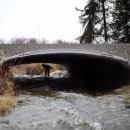States
MontanaThis project will open or improve fish passage fish passage
Fish passage is the ability of fish or other aquatic species to move freely throughout their life to find food, reproduce, and complete their natural migration cycles. Millions of barriers to fish passage across the country are fragmenting habitat and leading to species declines. The U.S. Fish and Wildlife Service's National Fish Passage Program is working to reconnect watersheds to benefit both wildlife and people.
Learn more about fish passage to more than 66 miles of rivers and streams in Western Montana through dam removals, culvert repairs and replacements, and other stream improvements. The project will benefit Arctic grayling, bull trout, and westslope cutthroat trout by improving access to habitat, providing colder water, restoring stream function, and reconnecting floodplains. In addition to enhancing the species’ resilience to the impacts of climate change climate change
Climate change includes both global warming driven by human-induced emissions of greenhouse gases and the resulting large-scale shifts in weather patterns. Though there have been previous periods of climatic change, since the mid-20th century humans have had an unprecedented impact on Earth's climate system and caused change on a global scale.
Learn more about climate change , these activities will contribute significantly to local watershed restoration efforts and will support local economic development and community resilience through infrastructure upgrades. This project builds on work from 2022 BIL funds for the Poorman Creek Culvert Removal.
Project Quick Facts:
| Project Status | In Development |
| Location | MT, Beaverhead/Lewis and Clark/Missoula/Powell County |
| NFPP Project Funding | $900,000 |
| Restoration Techniques | Culvert Replacement, Dam Removal |
| Accomplishments | 66 Stream Miles Reopened |
| Partner Project Lead | Partners for Fish and Wildlife Program |
The National Fish Passage Program combines technical expertise with a track record of success.
Implemented primarily through the Service's Fish and Wildlife Conservation Offices, the National Fish Passage Program provides financial and technical assistance to partners across the country. Since 1999, the program has worked with over 2,000 local communities, Tribes, and private landowners to remove or bypass over 3,400 barriers to fish passage and reopen access to over 61,000 miles of upstream habitat for fish and other animals. Staff have expertise in fish migration and biology as well as financial, engineering, and planning assistance to communities, Tribes, and landowners to help them remove barriers and restore rivers for the benefit both fish and people.
Fish passage project proposals can be initiated by any individual, organization, government, or agency. However, proposals must be submitted and completed in cooperation with a Fish and Wildlife Conservation Office. (Please note that fish passage projects being used for federal or state compensatory mitigation or required by existing federal or state regulatory programs are not eligible for funding through the National Fish Passage Program.)
CONTACT A FISH PASSAGE COORDINATOR IN YOUR AREA TO GET STARTED.

